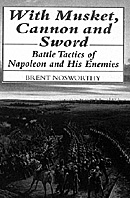 Author: Brent Nosworthy
Author: Brent Nosworthy
Pages: 536
Illustrations: 19 black and white photographs and drawings of period weaponry collected in a glossy center folio.
Maps and Diagrams: 26 black and white tactical diagrams showing battalions, regiments and batteries, along with necessary battle maps.
Footnotes: 732
Appendices: An invaluable glossary of terminology with 139 listings in 13 pages, including many French military terms.
Bibliography: 290 sources, including dozens of primary sources.
Index: 946 entries
Publisher: Sarpedon Publishers, NY
Publication Date: March, 1996
Binding: Cloth (hardbound)
ISBN: 1-885119-27-5
Price: $35.00
Summary: The publication of this book marks a major event for military history enthusiasts. Displaying obvious passion and impressive intellectual scope, Brent Nosworthy has written one of the finest accounts of the origins, evolution, and realities of Napoleonic tactics yet to be published.
Nosworthy, author of the highly regarded The Anatomy of Victory, Battle Tactics 1689-1763, is pre-eminently qualified to take up this scholarly quest, building as he does on an already impressive knowledge of Napoleonic combat antecedents. He has applied his previously successful methodology of amassing as much primary material as he could, and, once again, he has compiled a fresh and penetrating analysis. Nosworthy also acknowledges the invaluable works of other contemporary Napoleonic scholars, including such luminaries as George Nafziger, Paddy Griffith, John Elting, Christopher Duffy, David Chandler and Jean Lochet. While Nosworthy obviously has not done all the ground-breaking research himself, he is the first author to present a cogently distilled and highly readable account of what has been learned in the last twenty years of serious Napoleonic military scholarship.
One of Nosworthy's great talents is his ability to explain how a series of subtle and seemingly insignificant tactical alterations can yield what amounts to a revolution on the battlefield.
He writes: "By the opening of the French Revolutionary Wars, a deeper set of forces had already been at work for many years molding the shape, direction, and scope of the transformations of warfare that was to take place on the European battlefield. Engendered neither by changing social conditions nor the decline in the fighting capabilities of French fighting forces, this change was instead the inevitable product of a number of newly introduced practices, each in themselves small and not overly consequential. Their collective effect, nevertheless, went wildly beyond the expectations and designs of their authors."
In chapter after chapter, Nosworthy systematically delves into each aspect of Napoleonic combat, focusing on each arm (artillery, cavalry and infantry) in impressive detail. He also investigates and challenges nearly all the popular myths that have been handed down, including such ideas as the "invincibility of British firepower" as well as the romantic concept that French Revolutionary ardor was naturally embodied on the battlefield by the use of heavy columns. In each instance, Nosworthy presents valuable and fascinating evidence, and in a very balanced manner he weighs the validity of these notions.
Nosworthy systematically delves
into each aspect of
Napoleonic combat.
Also refreshing is that in a period of study that has often been hopelessly compromised by national prejudices, one instinctively trusts Noswor-thy's impeccable reasonableness and impartiality. He also possesses a good eye for discovering memorable first person accounts, and these passages help transform what could be a potentially dull and hopelessly technical topic into one that is absolutely fascinating.
Perhaps the book's most important contribution is in its effort to resurrect the study of tactics to its proper stage and importance in the larger discipline of history. Here Nosworthy challenges some of his more celebrated predecessors (such as John Keegan, among others). All too often, Nosworthy argues, we have allowed ourselves to be swayed by easy generalizations and sweeping descriptions -- or by popular theories based on selective evidence -- because, as Nosworthy notes, of the "...common historians' abhorrence of tactical issues...." But we ignore the weight of detail at our own peril, and at the expense of a more complicated and more substantial truth.
With Musket, Cannon and Sword is more than just an essential read for Napoleonic military history buffs. While no one book can be described as definitive on issues so-long enshrouded, Mr. Nosworthy's book is eye-opening time and time again, and it should help frame informed debate for some time to come (and, yes, it is sure to be controversial in many quarters). Certainly there are enough transcendant insights about the nature of battle, the evolution of tactics, and the interplay of these elements within culture at large, that, coupled with the book's underlying challenge to historians in general, make this work essential reading. At the very least, one can not fully appreciate Napoleonic military history without the kind of detailed understanding and presentation of challenging issues to be found in a book of this excellence and scope.
More Book Reviews:
-
Double Review: The Fatal Knot by John Lawrence Tone and Rod of Iron by Don W. Alexander
Back to Table of Contents -- Napoleon #2
© Copyright 1996 by Emperor's Press.
This article appears in MagWeb (Magazine Web) on the Internet World Wide Web.
The full text and graphics from other military history magazines and gaming magazines are available at http://www.magweb.com